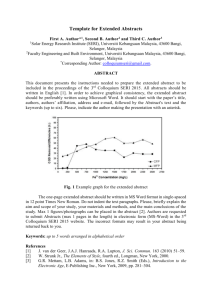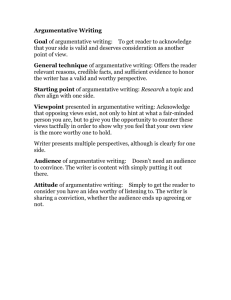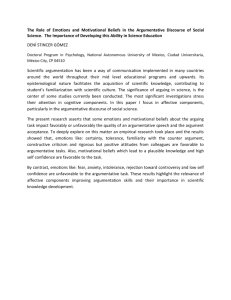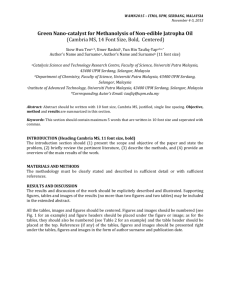effects of training in the use of argumentative structures on esl
advertisement
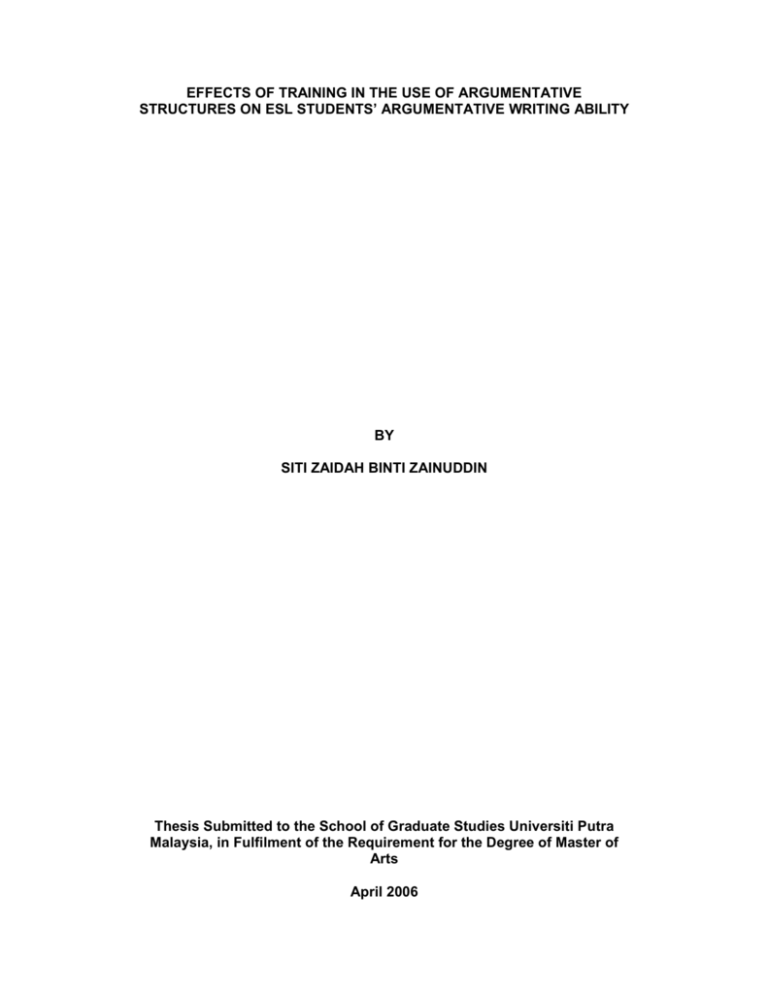
EFFECTS OF TRAINING IN THE USE OF ARGUMENTATIVE STRUCTURES ON ESL STUDENTS’ ARGUMENTATIVE WRITING ABILITY BY SITI ZAIDAH BINTI ZAINUDDIN Thesis Submitted to the School of Graduate Studies Universiti Putra Malaysia, in Fulfilment of the Requirement for the Degree of Master of Arts April 2006 DEDICATION This thesis is dedicated to my supervisor, Associate Professor Dr. Shameem Rafik Galea for being the force behind this project. My utmost appreciation for the guidance and unconditional support in helping me to complete this thesis. But above all, deepest gratitude for waking me up from my deep slumber. If not for her, this thesis would not be possible. iii Abstract of thesis presented to the Senate of Universiti Putra Malaysia in fulfilment of the requirement for the degree of Master of Arts EFFECTS OF TRAINING IN THE USE OF ARGUMENTATIVE STRUCTURES ON ESL STUDENTS’ ARGUMENTATIVE WRITING ABILITY By SITI ZAIDAH BINTI ZAINUDDIN April 2006 Chairman: Shameem Rafik-Galea Khan, PhD Faculty: Modern Languages and Communication This study mainly investigated the effectiveness of training in the structure of arguments based on Toulmin’s (1958) model of argument on ESL students’ argumentative writing. In addition, this study was carried out to find out the contributing factors on the students’ poor performance in writing arguments. Twenty-one Form Five students were selected based on their Form Four English Language result. The instruments used were pretest composition questions, posttest composition questions, and in-depth interviews. The data and results collected were analyzed using the SPSS for the percentage, mean, standard deviation and t-tests. The experimental group showed a significant difference in the mean scores for each element of arguments after the treatment suggesting that the students demonstrated greater knowledge of argument criteria. The findings also exhibited significant pre- to posttest gains based on the Holistic Critical Thinking Rubric and SPM Marking Band. Besides that, the subjects showed positive response to the use of argumentative structure. The results of the interviews with the teachers iv proved that teachers seldom teach argumentative writing in class and prefer students to choose either narrative or descriptive essays. The interviews also suggested that there were no specific methods in their argumentative writing class. The results of the brainstorming session concluded that the Toulmin model helped them in developing and organizing their writing. When interviewed, they agreed knowing the structure of arguments helped them in writing argumentative essays better. Thus, these results proved that knowledge of argumentative structure sharpens students’ judgment regarding the content and organization of writing argumentative essays. v Abstrak tesis yang dikemukakan kepada Senat Universiti Putra Malaysia sebagai memenuhi keperluan untuk mendapatkan ijazah Master Sastera KESAN LATIHAN MENGGUNAKAN STRUKTUR PENDAPAT KEPADA PERKEMBANGAN KARANGAN PERBAHASAN MURID-MURID Oleh SITI ZAIDAH BINTI ZAINUDDIN April 2006 Pengerusi: Shameem Rafik-Galea Khan, PhD Fakulti: Rekabentuk Fakulti Bahasa Moden dan Komunikasi kumpulan eksperimen-kuasi ini eksperimen ingin tidak menyelidik rawak, kesan praujian-pascaujian latihan struktur bahas berpandukan kepada model pendapat Toulmin (1958) ke atas pelajar-pelajar. Selain daripada itu, eksperimen ini juga bertujuan untuk mengenalpasti sebab-sebab pelajar tidak mahir di dalam penulisan karangan perbahasan. 21 orang pelajar dipilih berdasarkan keputusan Penilaian Akhir Bahasa Inggeris Tingkatan Empat. Alat ukur yang digunakan untuk mengumpul data adalah soalan karangan praujian da pascaujian serta temuduga terperinci. Data dan keputusan yang dikumpul dianalisiskan dengan menggunakan SPSS untuk mendapat peratus, min, sisihan piawai dan ujian-t. Keputusan menunjukkan bahawa ada perbezaan yang signifikan bagi kumpulan eksperimen keatas setiap elemen bahas. Selain daripada itu, keputusan daripada respon subjek ke atas latihan struktur bahas dalam penulisan karangan lebih positif. Analisis dari temuduga terperinci ke atas guru-guru mendapati bahawa mereka jarang mengajar penulisan karangan perbahasan di dalam kelas. Pelajar-pelajar mengakui bahawa model pendapat Toulmin ini membantu mereka dalam vi mengorganisasikan karangan pendapat mereka. Kesimpulan daripada kajian ini, dengan adanya pengetahuan tentang struktur bahas, pelajar dapat menajamkan lagi kebolehan mengadili isi-isi serta organisasi penulisan karangan perbahasan. vii ACKNOWLEDGEMENTS Working on this research has been extremely invaluable and a rewarding experience. This was made possible by the support, encouragement and guidance from many people. I would like to express my gratitude to Associate Professor Dr. Shameem Rafik Galea for her constant encouragement and guidance throughout this study; Dr. Noritah bt Omar for her brilliant views and Associate Professor Dr. Mohd. Majid b. Konting for his invaluable guidance and comments in the contents and statistics of this thesis; the Principal of SMK Abdul Jalil, Hulu Langat, Pn. Hj. Amnah bt Hashim for her support and encouragement; my husband, both my sons and my parents for their undivided support and concern and to all my students who have offered their time to make this thesis possible. Finally, I want to thank Universiti Putra Malaysia for awarding me the Fundamental Research Grant in order to carry out this research. viii I certify that an Examination Committee has met on 5th April 2004 to conduct the final examination of Siti Zaidah binti Zainuddin on her Master of Arts thesis entitled “Effects of Training in the use of Argumentative Structures on ESL Students’ Argumentative Writing Ability” in accordance with Universiti Pertanian Malaysia (Higher Degree) Act 1980 and Universiti Pertanian Malaysia (Higher Degree) Regulations 1981. The Committee recommends that the candidate be awarded the relevant degree. Members of the examination Committee are as follows: Wong Bee Eng, PhD Associate Professor Faculty of Modern Languages and Communication Universiti Putra Malaysia (Chairman) Wan Roselezam bt Wan Yahya, PhD Lecturer Faculty of Modern Languages and Communication Universiti Putra Malaysia (Member) Shamala d/o Paramasivan, PhD Lecturer Faculty of Modern Languages and Communication Universiti Putra Malaysia (Member) Azlina bt Murad Sani, PhD Associate Professor Faculty of Cognitive Science and Education Universiti Utara Malaysia (External Examiner) ____________________________ ZAKARIAH ABD. RASHID, PhD Professor/ Deputy Dean School of Graduate Studies Universiti Putra Malaysia Date: ix This thesis is submitted to the Senate of Universiti Putra Malaysia and has been accepted as fulfilment of the requirement for the degree of Master of Arts. The members of the Supervisory Committee are as follows: Shameem Rafik Galea-Khan, PhD Associate Professor Faculty of Modern Languages and Communication Universiti Putra Malaysia (Chairman) Noritah bt. Omar, PhD Lecturer Faculty of Modern Languages and Communication University Putra Malaysia (Member) Mohd. Majid b. Konting, PhD Associate Professor Faculty of Educational Studies Universiti Putra Malaysia (Member) _____________________ AINI IDERIS, PhD Professor/Dean School of Graduate Studies Universiti Putra Malaysia Date: x DECLARATION I hereby declare that the thesis is based on my original work except for quotations and citations which have been duly acknowledged. I also declare that it has not been previously or concurrently submitted for other degree at UPM or other institutions. ___________________________ SITI ZAIDAH BINTI ZAINUDDIN Date: 5 April 2006 xi TABLE OF CONTENTS Page DEDICATION ABSTRACT ACKNOWLEDGEMENTS APPROVAL DECLARATION LIST OF TABLES LIST OF FIGURES LIST OF ABBREVIATIONS iii iv viii ix ix xv xvii xix CHAPTERS 1 2 INTRODUCTION 1.1 Introduction 1.2 Background Information 1.2.1 Thinking and Writing 1 1 1 1.3 1.4 Statement of the Problem Research Questions 4 8 1.5 1.6 1.7 1.8 1.9 Purpose of the Study Theoretical Framework Significance of the Study Limitations of the Study Definitions of Key Terms 10 10 13 14 14 LITERATURE REVIEW 2.1 Introduction 2.2 Nature of Writing 2.2.1 A Definition of Writing 2.2.2 Theories of Writing 2.2.3 L1 vs L2 Writing 2.3 Approaches to Writing 2.3.1 The Product Approach 2.3.2 The Process Approach 2.4 Modes of Discourse 2.4.1 Narrative vs Argument 2.5 Arguments 2.5.1 Arguments: A Definition 2.5.2 Forms and Functions of Arguments 2.5.3 A Good Argument 2.6 Argumentative Writing 2.6.1 Problems and Difficulties in Writing Arguments 2.6.2 Strategies and Approaches to Improve Students’ 17 17 19 21 23 27 27 28 34 36 37 37 38 41 45 46 xii 2.7 2.8 2.9 2.10 2.11 3 4 Argumentative Perspectives and Writing The Toulmin Model and Argumentative Writing 2.7.1 Approach to the Toulmin Model 2.7.2 Process Approach to Writing Argumentative Writing and Critical Thinking 2.8.1 The Definitions and Conceptualization of Critical Thinking 2.8.2 The Importance of Critical Thinking The Relationship Between Writing and Critical Thinking Related Studies Conclusion METHODOLOGY 3.1 Introduction 3.2 Design of the Study 3.3 Aims of the Study 3.4 Subjects 3.5 Instruments 3.5.1 Interview Guide 3.5.2 Toulmin Instructional Model Guide and Materials 3.5.3 Pretest-Posttest Essay Prompts 3.6 Data Collection Procedures 3.6.1 Quantitative Data (Treatment) 3.6.2 Qualitative Data 3.7 Data Analysis Procedures 3.7.1 The Toulmin Scoring Criteria 3.7.2 Holistic Critical Thinking Scoring Rubric 3.7.3 SPM Marking Band 3.7.4 Inter Reliability Test 3.7.5 Analysis of the Interviews and Essays 3.8 Pilot Study 3.8.1 Results of the Pilot Study 3.9 Conclusions RESULTS AND DISCUSSION 4.1 Introduction 4.2 Analysis of Quantitative Data 4.2.1 Section 1- Statistical Data 4.2.2 Section 2- Analysis of Sample Essays 4.3 Analysis of Qualitative Data 4.3.1 Analysis form Interviews with the Teachers 4.3.2 Analysis of the Students’ Perception of Writing Argumentative Essays 4.3.3 Analysis of the Students Brainstorming Session 4.3.4 Analysis of the Interview with Students- Posttest 4.4 Discussion of Research Findings 4.5 Conclusion 56 59 63 66 71 74 76 79 84 92 94 94 96 98 100 103 104 107 109 110 114 118 120 123 123 124 128 130 132 135 136 136 137 155 182 183 189 192 197 198 204 xiii 5 CONCLUSION 5.1 Introduction 5.2 Summary of the Study 5.3 Summary of the Overall Findings 5.4 Implications of the Study 5.5 Recommendations 5.6 Suggestion for Future Research 5.7 Concluding Remarks REFERENCES APPENDICES BIODATA OF THE AUTHOR 205 205 206 208 209 210 211 213 227 287 xiv





